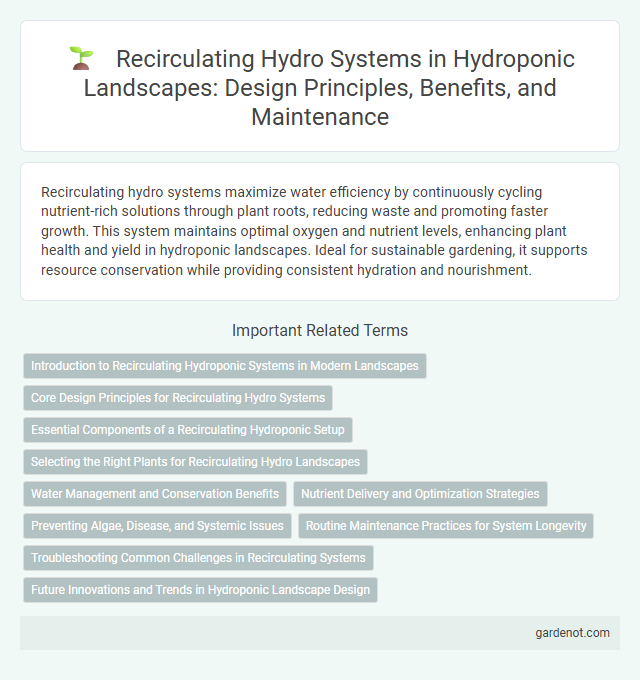Recirculating hydro systems maximize water efficiency by continuously cycling nutrient-rich solutions through plant roots, reducing waste and promoting faster growth. This system maintains optimal oxygen and nutrient levels, enhancing plant health and yield in hydroponic landscapes. Ideal for sustainable gardening, it supports resource conservation while providing consistent hydration and nourishment.
Introduction to Recirculating Hydroponic Systems in Modern Landscapes
Recirculating hydroponic systems efficiently reuse nutrient-rich water, minimizing waste in modern landscapes while promoting sustainable plant growth. These closed-loop setups maintain optimal nutrient and pH levels through constant water circulation, enhancing oxygen availability to roots and improving overall crop yield. Integration of recirculating systems in urban landscaping reduces water consumption by up to 90% compared to traditional irrigation methods.
Core Design Principles for Recirculating Hydro Systems
Recirculating hydroponic systems rely on closed-loop water circulation to optimize nutrient delivery and minimize waste. Core design principles include maintaining an ideal water flow rate to prevent stagnation, ensuring consistent oxygenation to promote root health, and implementing effective filtration to remove contaminants. Proper system balance enhances plant growth efficiency and reduces resource consumption in hydroponic landscapes.
Essential Components of a Recirculating Hydroponic Setup
A recirculating hydroponic system relies on essential components such as a nutrient reservoir, submersible pump, and delivery tubing to continuously circulate nutrient-rich water to plant roots. Air stones and air pumps ensure proper oxygenation, while growing trays or channels support plant growth and facilitate water flow. Monitoring equipment like pH and EC meters optimize nutrient balance and system efficiency in a recirculating hydroponic setup.
Selecting the Right Plants for Recirculating Hydro Landscapes
Selecting the right plants for recirculating hydroponic landscapes involves choosing species that thrive in constant water flow and nutrient availability, such as lettuce, herbs, and leafy greens. Optimal plant selection enhances nutrient uptake efficiency and supports healthy root systems in aquaponic or hydroponic environments. Understanding each plant's water and nutrient requirements ensures maximum growth and reduces risk of clogging or disease in the recirculating system.
Water Management and Conservation Benefits
Recirculating hydroponic systems optimize water management by continuously cycling nutrient-rich water through plants, reducing overall water consumption by up to 90% compared to traditional soil-based cultivation. This closed-loop design minimizes water waste and prevents runoff, enhancing sustainability in landscape applications. Efficient water use and nutrient retention in these systems support conservation efforts while promoting healthy plant growth.
Nutrient Delivery and Optimization Strategies
Recirculating hydroponic systems enhance nutrient delivery by continuously cycling nutrient-rich water through plant roots, ensuring consistent availability of essential minerals such as nitrogen, phosphorus, and potassium. Optimization strategies include monitoring and adjusting pH levels between 5.5 and 6.5, maintaining electrical conductivity (EC) within 1.2-2.0 dS/m, and implementing automated sensors to regulate nutrient concentration and oxygenation. This approach reduces water and nutrient waste while maximizing plant growth efficiency and yield in controlled environments.
Preventing Algae, Disease, and Systemic Issues
Recirculating hydroponic systems reduce water waste by continuously circulating nutrient-rich solutions, but effective algae prevention is crucial to maintain system health. Using opaque reservoirs, controlling light exposure, and regularly cleaning components minimize algae growth that can harbor pathogens and lead to disease outbreaks. Incorporating proper filtration and monitoring pH and nutrient levels help prevent systemic issues, ensuring optimal plant growth and system longevity.
Routine Maintenance Practices for System Longevity
Routine maintenance practices for recirculating hydroponic systems include regularly monitoring pH and nutrient levels to ensure optimal plant growth and prevent system imbalances. Cleaning and disinfecting reservoirs, pumps, and tubing at least once a week prevents algae buildup and biofilm formation, which can clog the system and reduce efficiency. Inspecting and replacing worn-out components such as filters, air stones, and grow media improves system longevity and maintains consistent water flow and oxygenation.
Troubleshooting Common Challenges in Recirculating Systems
Recirculating hydroponic systems often face challenges such as clogging in pumps and tubing due to nutrient buildup or algae growth, which can be resolved by regular cleaning and filtration maintenance. pH fluctuations and nutrient imbalances frequently occur, necessitating consistent monitoring and adjustment to optimize plant nutrient uptake. Oxygen depletion in the water can lead to root rot, making aeration devices and dissolved oxygen measurements critical for system health.
Future Innovations and Trends in Hydroponic Landscape Design
Recirculating hydro systems in hydroponic landscape design are evolving with advanced sensor technology and AI-driven nutrient management, enabling precise control over water and nutrient delivery to optimize plant growth. Emerging trends include the integration of renewable energy sources and automated drone monitoring to enhance sustainability and efficiency in urban green spaces. Future innovations are poised to incorporate biodegradable components and smart irrigation algorithms, reducing environmental impact while maximizing aesthetic and functional benefits.
Recirculating hydro system Infographic

 gardenot.com
gardenot.com